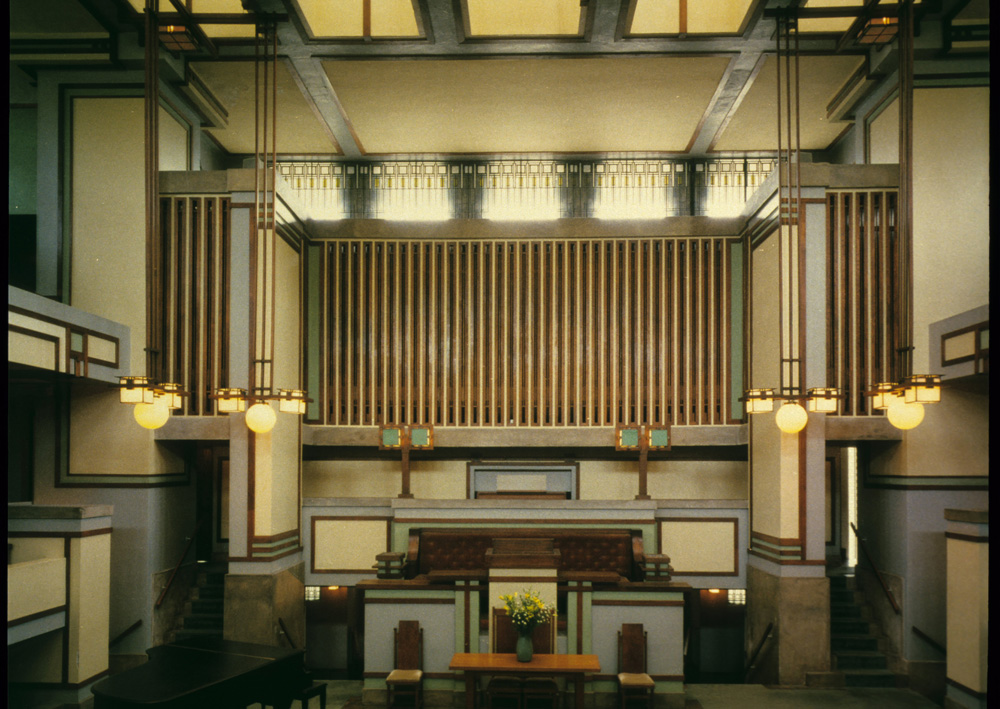
The National Trust for Historic Preservation announced its annual list of the most endangered historic places in the United States today, ranging from the sacred site of Mount Taylor, New Mexico to the Enola Gay Hangar at Wendover Airfield in Utah. Among the 11 sites on this year’s list are:
* Unity Temple in Oak Park, Illinois Designed for Frank Lloyd Wright’s own Unitarian congregation, the temple is widely acknowledged as an icon of 20th-century architecture and is the only surviving public structure from Wright’s Prairie period. Dedicated in September 1909, the flat-roofed cubic building was also one of the earliest public structures to feature exposed concrete, one of Wright’s signature design elements. Years of water infiltration have compromised the building prompting a multimillion-dollar rescue effort that includes conserving its more than 75 art glass windows, and repairing its original Magnesite floors.
* Ames Shovel Shops complex in Easton, Massachusetts An intact 19th-century industrial village composed of an eight-acre site comprising 15 granite and wood buildings dating from 1852 through 1928. The Ames Shovel Works was established by Oliver Ames (son of the blacksmith Captain John Ames) in 1803, and by 1870 sold 60% of the shovels used worldwide. The complex is threatened by a plan to demolish several of the historic buildings and radically alter others to pave the way for new mixed-use development.
* Miami Marine Stadium on Virginia Key, Florida Completed in 1963, Miami Marine Stadium is both a South Florida landmark and an icon of modern design. Built entirely of poured concrete and featuring a dramatically cantilevered folded-plate roof, the 6,566-seat stadium was designed by Cuban-born architect Hilario Candela and became a favorite local venue for concerts and other events. It was closed after sustaining damage during Hurricane Andrew in 1992, and has since suffered years of deterioration, vandalism and neglect. Its Biscayne Bay location makes it a prime target for developers, however the Friends of Miami Marine Stadium is working hard to ensure its preservation.
* Cast-Iron Architecture of Galveston, Texas This assemblage of late 19th-century Greek revival and Italianate buildings in Galveston’s 12-block Strand/Mechanic National Historic Landmark District is one of the largest collections of historic commercial buildings in the country. Widespread flooding caused by Hurricane Ike in September 2008, which buried the downtown commercial district under 10-13 feet of salt water, oil, and debris for two days, caused extensive damage to both the structural integrity and decorative details of these cast-iron storefronts and buildings.
* Century Plaza Hotel in Los Angeles, California Opened in 1966 as the centerpiece of the Century City complex, this 19-story curved hotel was designed by the renowned architect Minoru Yamasaki, who later designed New York City’s World Trade Center. The Century Plaza was a favorite destination for both Presidents Richard Nixon and Ronald Reagan, earning it the nickname “The West Coast White House.” The hotel received a $36 million facelift just over a year ago, however its new owners plan to raze it and replace it with two 600-foot “green” towers—a proposal that is widely countered by the sustainability claims of architectural preservation.
For more information, to watch related videos, share stories, or learn how to help preserve these and other sites visit www.preservationnation.org.
